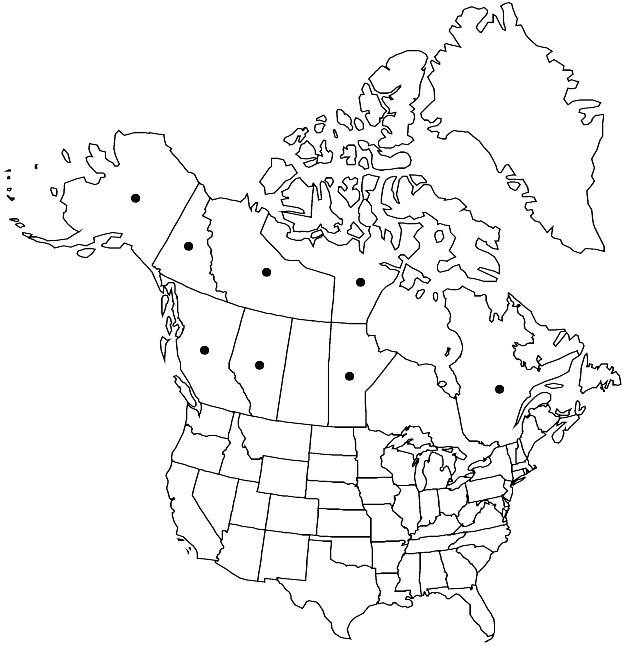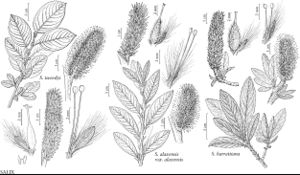Difference between revisions of "Salix alaxensis"
Proc. Wash. Acad. Sci. 2: 280. 1900.
FNA>Volume Importer |
imported>Volume Importer |
||
| Line 8: | Line 8: | ||
}} | }} | ||
|common_names=Felt-leaf willow | |common_names=Felt-leaf willow | ||
| + | |special_status={{Treatment/ID/Special_status | ||
| + | |code=F | ||
| + | |label=Illustrated | ||
| + | }} | ||
|basionyms={{Treatment/ID/Basionym | |basionyms={{Treatment/ID/Basionym | ||
|name=Salix speciosa var. alaxensis | |name=Salix speciosa var. alaxensis | ||
| Line 26: | Line 30: | ||
-->{{Treatment/Body | -->{{Treatment/Body | ||
| − | |distribution= | + | |distribution=Alta.;B.C.;Man.;N.W.T.;Nunavut;Que.;Yukon;Alaska;Asia (n;e Siberia). |
|discussion=<p>Varieties 2 (2 in the flora).</p><!-- | |discussion=<p>Varieties 2 (2 in the flora).</p><!-- | ||
--><p><i>Salix alaxensis</i> is often used in northern regions for revegetation of disturbed sites and for wildlife habitat restoration (R. A. Densmore et al. 1987).</p> | --><p><i>Salix alaxensis</i> is often used in northern regions for revegetation of disturbed sites and for wildlife habitat restoration (R. A. Densmore et al. 1987).</p> | ||
| Line 57: | Line 61: | ||
|basionyms=Salix speciosa var. alaxensis | |basionyms=Salix speciosa var. alaxensis | ||
|family=Salicaceae | |family=Salicaceae | ||
| − | |distribution= | + | |distribution=Alta.;B.C.;Man.;N.W.T.;Nunavut;Que.;Yukon;Alaska;Asia (n;e Siberia). |
|reference=None | |reference=None | ||
|publication title=Proc. Wash. Acad. Sci. | |publication title=Proc. Wash. Acad. Sci. | ||
|publication year=1900 | |publication year=1900 | ||
| − | |special status= | + | |special status=Illustrated |
| − | |source xml=https:// | + | |source xml=https://bibilujan@bitbucket.org/aafc-mbb/fna-data-curation.git/src/bb6b7e3a7de7d3b7888a1ad48c7fd8f5c722d8d6/coarse_grained_fna_xml/V7/V7_163.xml |
|genus=Salix | |genus=Salix | ||
|subgenus=Salix subg. Vetrix | |subgenus=Salix subg. Vetrix | ||
Revision as of 00:54, 28 May 2020
Shrubs or trees, 1–7 m. Stems: branches yellow-brown or red-brown, not glaucous, glabrous or villous; branchlets gray-brown or red-brown, glabrescent or villous. Leaves: stipules (sometimes marcescent), foliaceous, (3–23 mm), apex acuminate to acute; petiole convex to flat, or shallowly grooved adaxially, 3–20 mm, tomentose adaxially, (strongly ventricose around floral buds); largest medial blade broadly oblong, narrowly oblong, narrowly elliptic to elliptic, narrowly oblanceolate, oblanceolate, obovate, or broadly obovate, 50–110 × 13–35 mm, 2–4 times as long as wide, base cuneate or convex, margins strongly revolute, entire or crenate, apex acuminate, acute, or convex, abaxial surface glaucous or not (usually obscured by hairs, midrib yellowish), densely tomentose or villous-tomentose, hairs wavy, adaxial dull, sparsely or moderately densely villous (floccose) to glabrescent, (hairs white or gray); proximal blade margins entire; juvenile blade reddish or yellowish green (color often obscured by hairs), very densely woolly-tomentose abaxially, hairs white. Catkins flowering before leaves emerge; staminate stout, 23–55 × 13–27 mm, flowering branchlet 0–6 mm; pistillate densely flowered, slender to stout, 33–103 × 8–22 mm, flowering branchlet 0–13 mm; floral bract brown or black, 1.5–2–2.5 mm, apex acute to convex, abaxially sparsely hairy, hairs straight. Staminate flowers: adaxial nectary narrowly oblong to oblong, 0.5–1.4 mm; filaments distinct; anthers purple turning yellow, long-cylindrical, 0.6–0.9 mm. Pistillate flowers: adaxial nectary narrowly oblong, 0.6–1.6 mm; stipe 0–0.4 mm; ovary pyriform, (hairs refractive, wavy), beak gradually tapering to styles; ovules 14–18 per ovary; styles 1.3–2.8 mm; stigmas 0.4–0.99–1.28 mm. Capsules 4–5 mm.
Distribution

Alta., B.C., Man., N.W.T., Nunavut, Que., Yukon, Alaska, Asia (n, e Siberia).
Discussion
Varieties 2 (2 in the flora).
Salix alaxensis is often used in northern regions for revegetation of disturbed sites and for wildlife habitat restoration (R. A. Densmore et al. 1987).
Selected References
None.
Key
| 1 | Branchlets not noticeably glaucous, very densely villous; largest medial blades: midrib evident, moderately densely tomentose to sparsely pubescent, abaxial surface not noticeably glaucous. | Salix alaxensis var. alaxensis |
| 1 | Branchlets strongly glaucous, glabrescent or sparsely villous; largest medial blades: midrib prominent, sparsely pubescent to glabrescent, abaxial surface noticeably glaucous or not. | Salix alaxensis var. longistylis |
